Report: Law and Legal System - Business Law, Semester 1
VerifiedAdded on 2021/02/20
|14
|3132
|314
Report
AI Summary
This report provides a comprehensive overview of the law and legal system, encompassing various sources of law such as common law, statutes, European law, and human rights law. It explores the role of government in law-making, including its legislative, executive, and judicial functions, and examines the application of common and statutory law in justice courts. The report further analyzes the impact of company, employment, and contract law on businesses, differentiating between legislation, regulations, and standards. It details the legal formation, management, and funding of different business organizations, including sole proprietorships, partnerships, companies, and LLPs. Additionally, it discusses legal solutions for resolving disputes and compares different sources of legal advice, concluding with an evaluation of the effectiveness of the UK legal system and its recent reforms and developments. This report is designed to provide students with a clear understanding of key legal concepts and their practical applications in a business context.
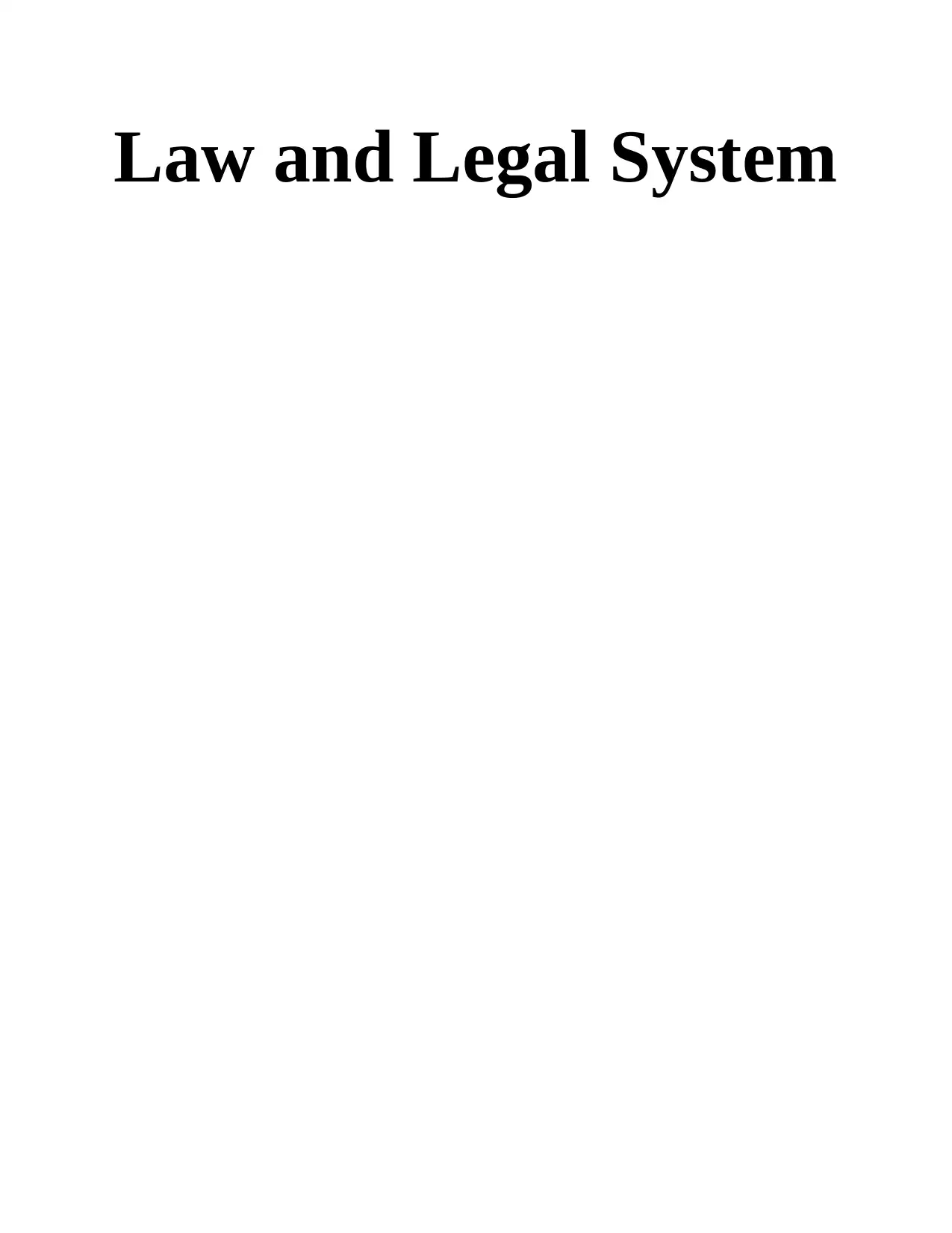
Law and Legal System
Paraphrase This Document
Need a fresh take? Get an instant paraphrase of this document with our AI Paraphraser
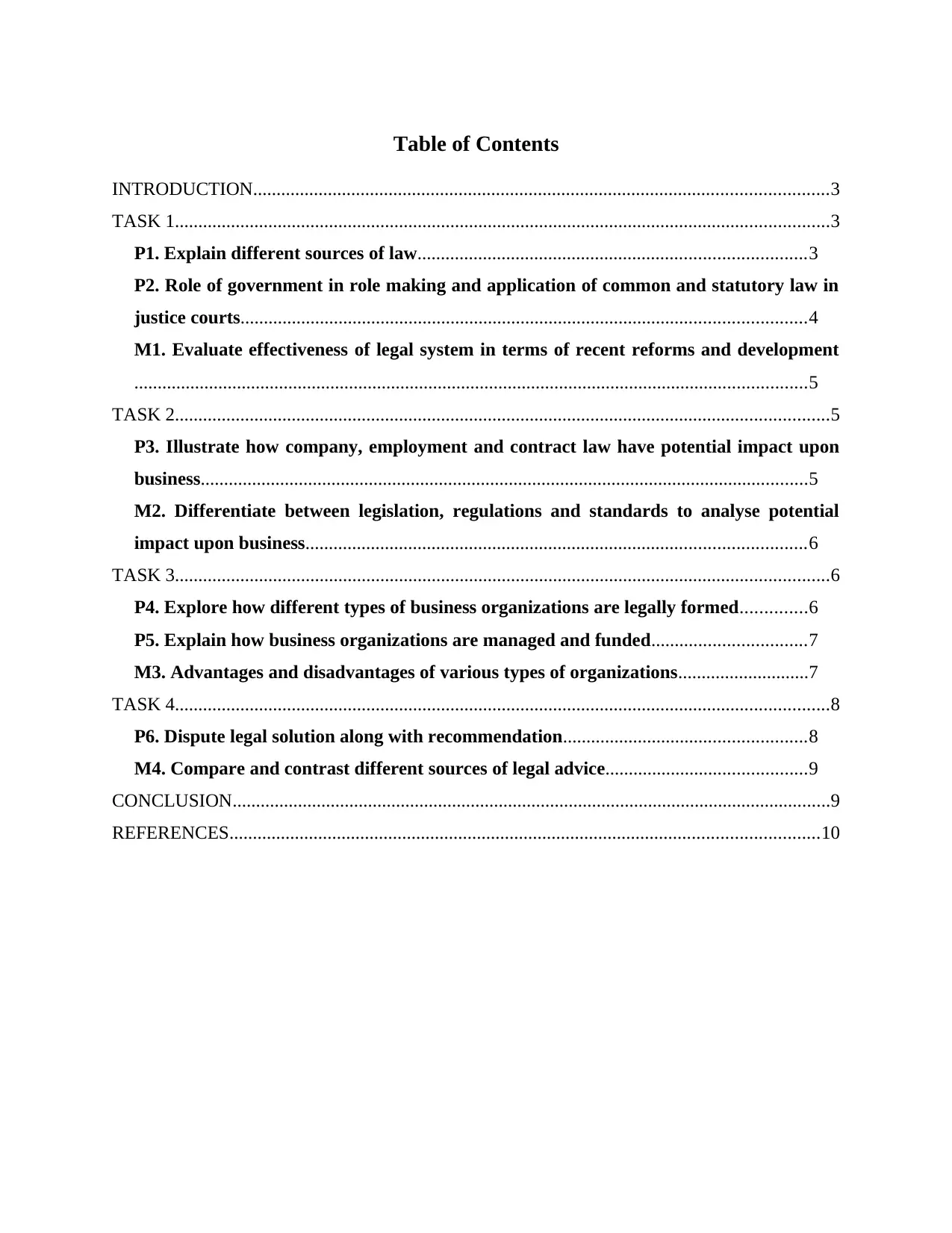
Table of Contents
INTRODUCTION...........................................................................................................................3
TASK 1............................................................................................................................................3
P1. Explain different sources of law...................................................................................3
P2. Role of government in role making and application of common and statutory law in
justice courts.........................................................................................................................4
M1. Evaluate effectiveness of legal system in terms of recent reforms and development
................................................................................................................................................5
TASK 2............................................................................................................................................5
P3. Illustrate how company, employment and contract law have potential impact upon
business..................................................................................................................................5
M2. Differentiate between legislation, regulations and standards to analyse potential
impact upon business...........................................................................................................6
TASK 3............................................................................................................................................6
P4. Explore how different types of business organizations are legally formed..............6
P5. Explain how business organizations are managed and funded.................................7
M3. Advantages and disadvantages of various types of organizations............................7
TASK 4............................................................................................................................................8
P6. Dispute legal solution along with recommendation....................................................8
M4. Compare and contrast different sources of legal advice...........................................9
CONCLUSION................................................................................................................................9
REFERENCES..............................................................................................................................10
INTRODUCTION...........................................................................................................................3
TASK 1............................................................................................................................................3
P1. Explain different sources of law...................................................................................3
P2. Role of government in role making and application of common and statutory law in
justice courts.........................................................................................................................4
M1. Evaluate effectiveness of legal system in terms of recent reforms and development
................................................................................................................................................5
TASK 2............................................................................................................................................5
P3. Illustrate how company, employment and contract law have potential impact upon
business..................................................................................................................................5
M2. Differentiate between legislation, regulations and standards to analyse potential
impact upon business...........................................................................................................6
TASK 3............................................................................................................................................6
P4. Explore how different types of business organizations are legally formed..............6
P5. Explain how business organizations are managed and funded.................................7
M3. Advantages and disadvantages of various types of organizations............................7
TASK 4............................................................................................................................................8
P6. Dispute legal solution along with recommendation....................................................8
M4. Compare and contrast different sources of legal advice...........................................9
CONCLUSION................................................................................................................................9
REFERENCES..............................................................................................................................10
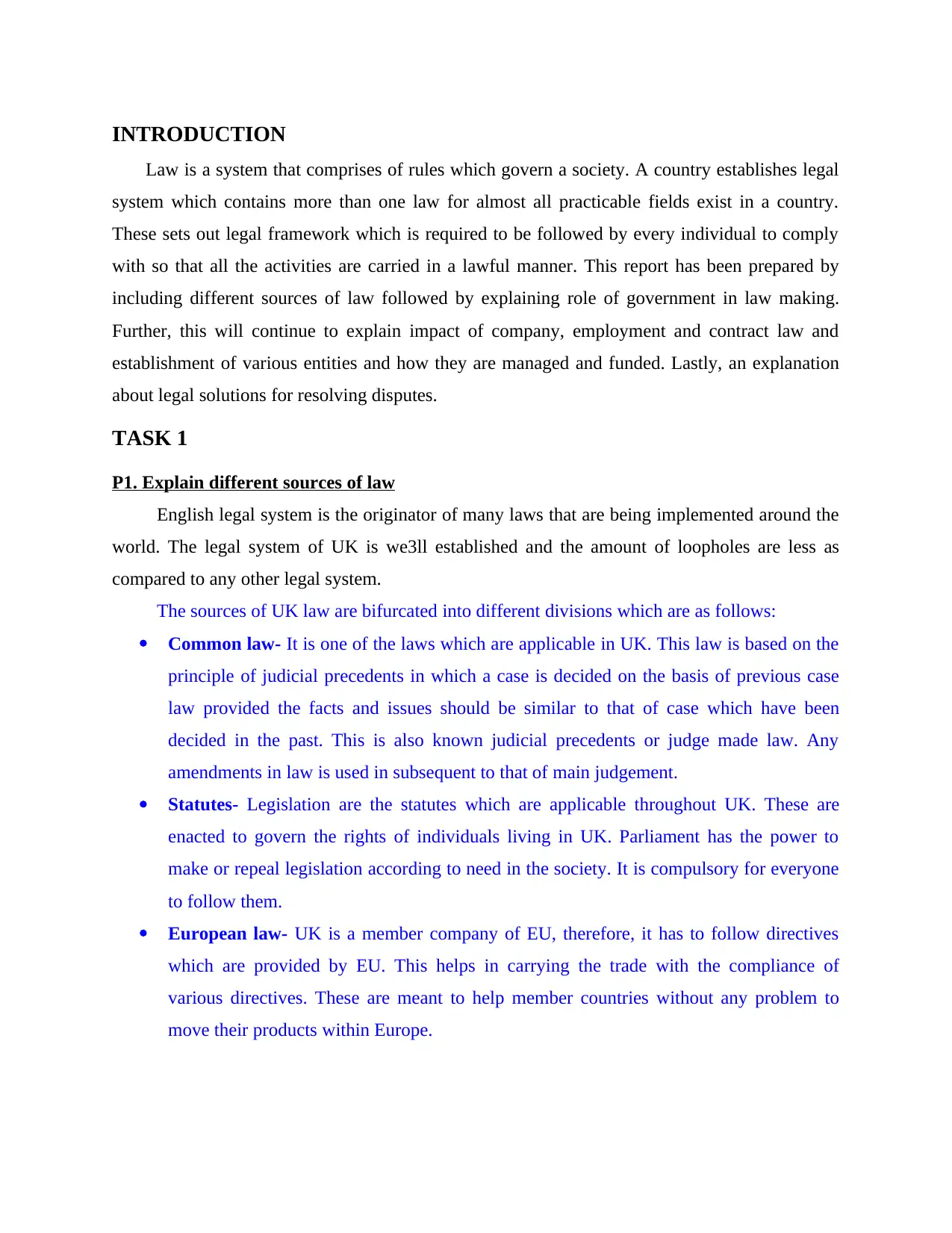
INTRODUCTION
Law is a system that comprises of rules which govern a society. A country establishes legal
system which contains more than one law for almost all practicable fields exist in a country.
These sets out legal framework which is required to be followed by every individual to comply
with so that all the activities are carried in a lawful manner. This report has been prepared by
including different sources of law followed by explaining role of government in law making.
Further, this will continue to explain impact of company, employment and contract law and
establishment of various entities and how they are managed and funded. Lastly, an explanation
about legal solutions for resolving disputes.
TASK 1
P1. Explain different sources of law
English legal system is the originator of many laws that are being implemented around the
world. The legal system of UK is we3ll established and the amount of loopholes are less as
compared to any other legal system.
The sources of UK law are bifurcated into different divisions which are as follows:
Common law- It is one of the laws which are applicable in UK. This law is based on the
principle of judicial precedents in which a case is decided on the basis of previous case
law provided the facts and issues should be similar to that of case which have been
decided in the past. This is also known judicial precedents or judge made law. Any
amendments in law is used in subsequent to that of main judgement.
Statutes- Legislation are the statutes which are applicable throughout UK. These are
enacted to govern the rights of individuals living in UK. Parliament has the power to
make or repeal legislation according to need in the society. It is compulsory for everyone
to follow them.
European law- UK is a member company of EU, therefore, it has to follow directives
which are provided by EU. This helps in carrying the trade with the compliance of
various directives. These are meant to help member countries without any problem to
move their products within Europe.
Law is a system that comprises of rules which govern a society. A country establishes legal
system which contains more than one law for almost all practicable fields exist in a country.
These sets out legal framework which is required to be followed by every individual to comply
with so that all the activities are carried in a lawful manner. This report has been prepared by
including different sources of law followed by explaining role of government in law making.
Further, this will continue to explain impact of company, employment and contract law and
establishment of various entities and how they are managed and funded. Lastly, an explanation
about legal solutions for resolving disputes.
TASK 1
P1. Explain different sources of law
English legal system is the originator of many laws that are being implemented around the
world. The legal system of UK is we3ll established and the amount of loopholes are less as
compared to any other legal system.
The sources of UK law are bifurcated into different divisions which are as follows:
Common law- It is one of the laws which are applicable in UK. This law is based on the
principle of judicial precedents in which a case is decided on the basis of previous case
law provided the facts and issues should be similar to that of case which have been
decided in the past. This is also known judicial precedents or judge made law. Any
amendments in law is used in subsequent to that of main judgement.
Statutes- Legislation are the statutes which are applicable throughout UK. These are
enacted to govern the rights of individuals living in UK. Parliament has the power to
make or repeal legislation according to need in the society. It is compulsory for everyone
to follow them.
European law- UK is a member company of EU, therefore, it has to follow directives
which are provided by EU. This helps in carrying the trade with the compliance of
various directives. These are meant to help member countries without any problem to
move their products within Europe.
⊘ This is a preview!⊘
Do you want full access?
Subscribe today to unlock all pages.

Trusted by 1+ million students worldwide
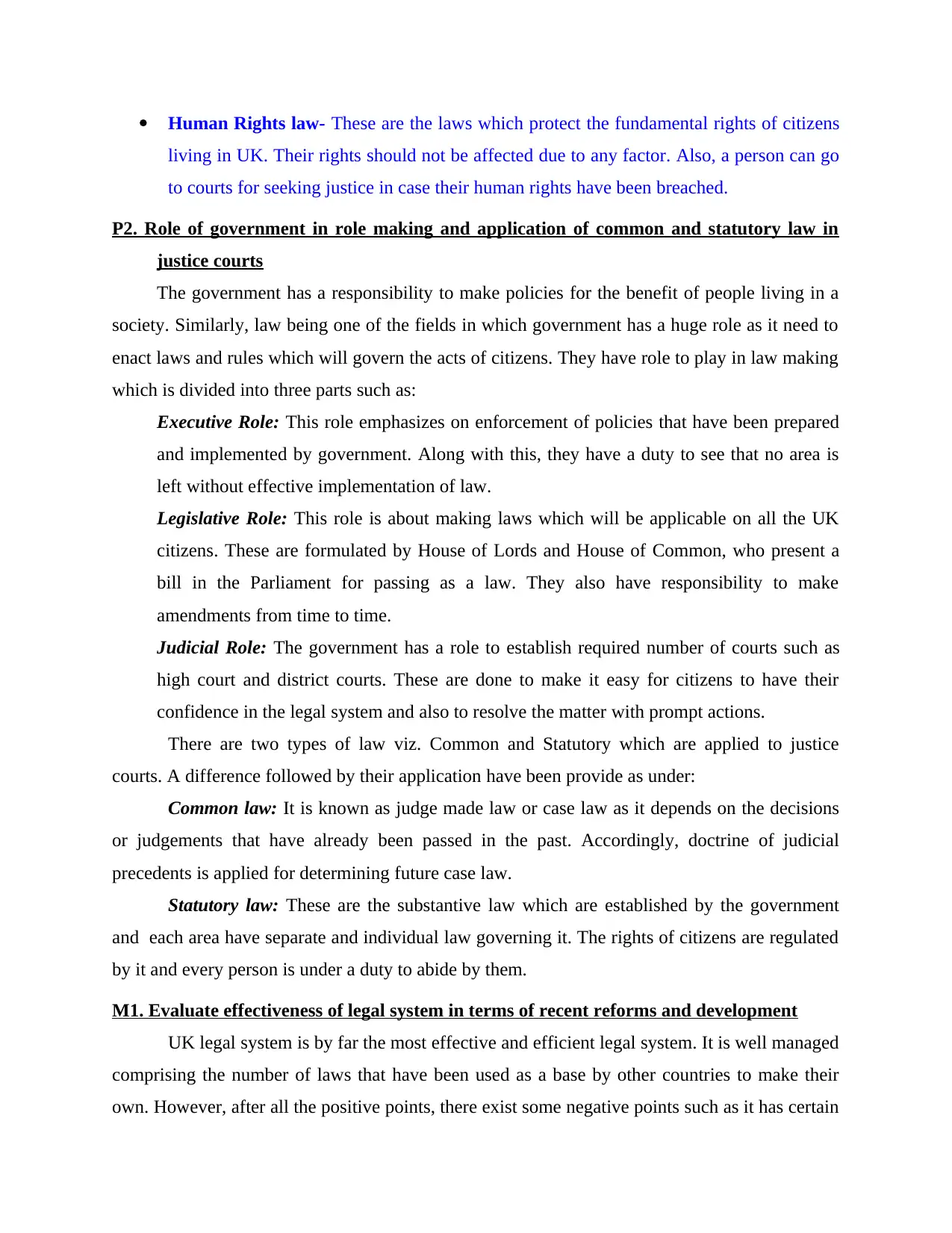
Human Rights law- These are the laws which protect the fundamental rights of citizens
living in UK. Their rights should not be affected due to any factor. Also, a person can go
to courts for seeking justice in case their human rights have been breached.
P2. Role of government in role making and application of common and statutory law in
justice courts
The government has a responsibility to make policies for the benefit of people living in a
society. Similarly, law being one of the fields in which government has a huge role as it need to
enact laws and rules which will govern the acts of citizens. They have role to play in law making
which is divided into three parts such as:
Executive Role: This role emphasizes on enforcement of policies that have been prepared
and implemented by government. Along with this, they have a duty to see that no area is
left without effective implementation of law.
Legislative Role: This role is about making laws which will be applicable on all the UK
citizens. These are formulated by House of Lords and House of Common, who present a
bill in the Parliament for passing as a law. They also have responsibility to make
amendments from time to time.
Judicial Role: The government has a role to establish required number of courts such as
high court and district courts. These are done to make it easy for citizens to have their
confidence in the legal system and also to resolve the matter with prompt actions.
There are two types of law viz. Common and Statutory which are applied to justice
courts. A difference followed by their application have been provide as under:
Common law: It is known as judge made law or case law as it depends on the decisions
or judgements that have already been passed in the past. Accordingly, doctrine of judicial
precedents is applied for determining future case law.
Statutory law: These are the substantive law which are established by the government
and each area have separate and individual law governing it. The rights of citizens are regulated
by it and every person is under a duty to abide by them.
M1. Evaluate effectiveness of legal system in terms of recent reforms and development
UK legal system is by far the most effective and efficient legal system. It is well managed
comprising the number of laws that have been used as a base by other countries to make their
own. However, after all the positive points, there exist some negative points such as it has certain
living in UK. Their rights should not be affected due to any factor. Also, a person can go
to courts for seeking justice in case their human rights have been breached.
P2. Role of government in role making and application of common and statutory law in
justice courts
The government has a responsibility to make policies for the benefit of people living in a
society. Similarly, law being one of the fields in which government has a huge role as it need to
enact laws and rules which will govern the acts of citizens. They have role to play in law making
which is divided into three parts such as:
Executive Role: This role emphasizes on enforcement of policies that have been prepared
and implemented by government. Along with this, they have a duty to see that no area is
left without effective implementation of law.
Legislative Role: This role is about making laws which will be applicable on all the UK
citizens. These are formulated by House of Lords and House of Common, who present a
bill in the Parliament for passing as a law. They also have responsibility to make
amendments from time to time.
Judicial Role: The government has a role to establish required number of courts such as
high court and district courts. These are done to make it easy for citizens to have their
confidence in the legal system and also to resolve the matter with prompt actions.
There are two types of law viz. Common and Statutory which are applied to justice
courts. A difference followed by their application have been provide as under:
Common law: It is known as judge made law or case law as it depends on the decisions
or judgements that have already been passed in the past. Accordingly, doctrine of judicial
precedents is applied for determining future case law.
Statutory law: These are the substantive law which are established by the government
and each area have separate and individual law governing it. The rights of citizens are regulated
by it and every person is under a duty to abide by them.
M1. Evaluate effectiveness of legal system in terms of recent reforms and development
UK legal system is by far the most effective and efficient legal system. It is well managed
comprising the number of laws that have been used as a base by other countries to make their
own. However, after all the positive points, there exist some negative points such as it has certain
Paraphrase This Document
Need a fresh take? Get an instant paraphrase of this document with our AI Paraphraser
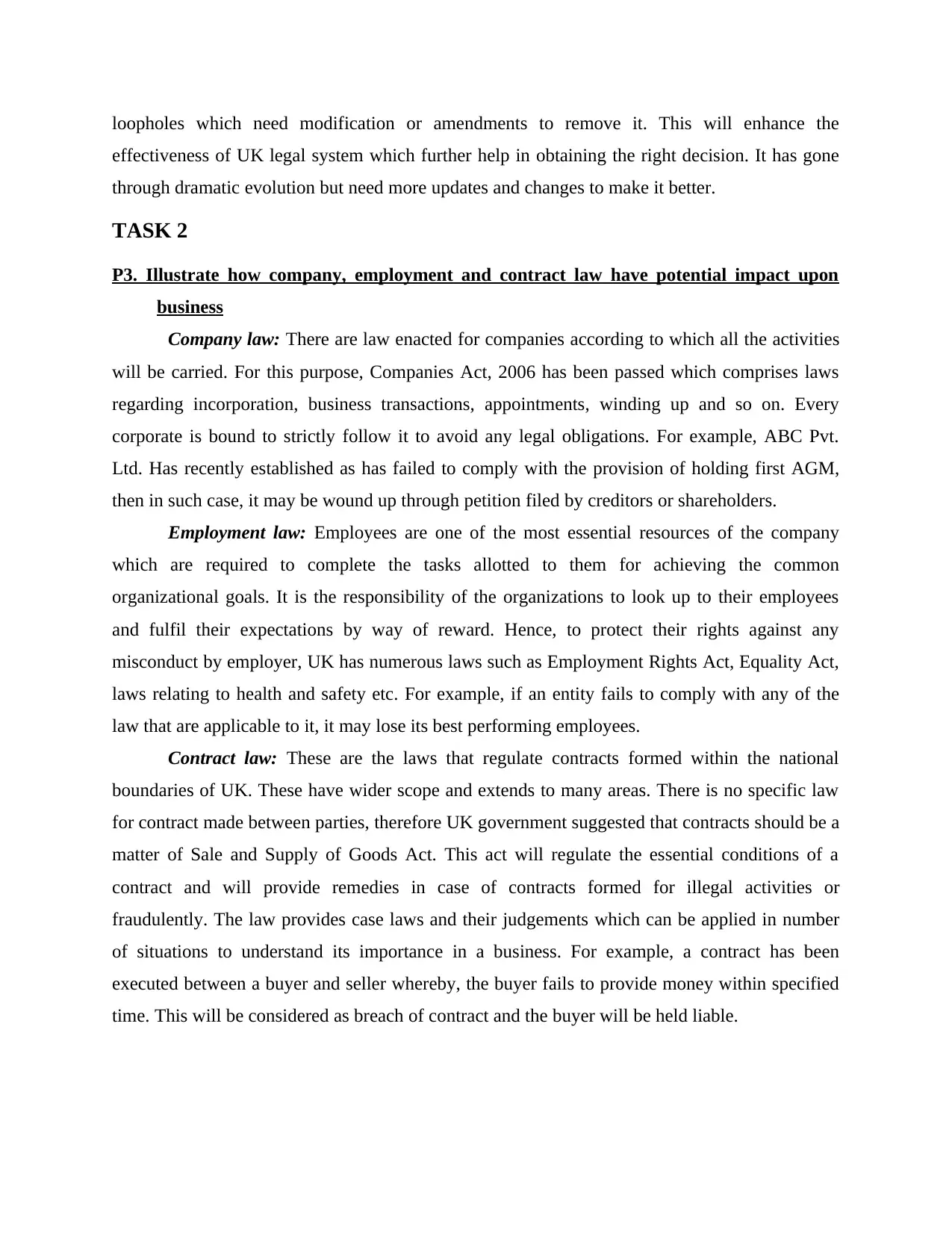
loopholes which need modification or amendments to remove it. This will enhance the
effectiveness of UK legal system which further help in obtaining the right decision. It has gone
through dramatic evolution but need more updates and changes to make it better.
TASK 2
P3. Illustrate how company, employment and contract law have potential impact upon
business
Company law: There are law enacted for companies according to which all the activities
will be carried. For this purpose, Companies Act, 2006 has been passed which comprises laws
regarding incorporation, business transactions, appointments, winding up and so on. Every
corporate is bound to strictly follow it to avoid any legal obligations. For example, ABC Pvt.
Ltd. Has recently established as has failed to comply with the provision of holding first AGM,
then in such case, it may be wound up through petition filed by creditors or shareholders.
Employment law: Employees are one of the most essential resources of the company
which are required to complete the tasks allotted to them for achieving the common
organizational goals. It is the responsibility of the organizations to look up to their employees
and fulfil their expectations by way of reward. Hence, to protect their rights against any
misconduct by employer, UK has numerous laws such as Employment Rights Act, Equality Act,
laws relating to health and safety etc. For example, if an entity fails to comply with any of the
law that are applicable to it, it may lose its best performing employees.
Contract law: These are the laws that regulate contracts formed within the national
boundaries of UK. These have wider scope and extends to many areas. There is no specific law
for contract made between parties, therefore UK government suggested that contracts should be a
matter of Sale and Supply of Goods Act. This act will regulate the essential conditions of a
contract and will provide remedies in case of contracts formed for illegal activities or
fraudulently. The law provides case laws and their judgements which can be applied in number
of situations to understand its importance in a business. For example, a contract has been
executed between a buyer and seller whereby, the buyer fails to provide money within specified
time. This will be considered as breach of contract and the buyer will be held liable.
effectiveness of UK legal system which further help in obtaining the right decision. It has gone
through dramatic evolution but need more updates and changes to make it better.
TASK 2
P3. Illustrate how company, employment and contract law have potential impact upon
business
Company law: There are law enacted for companies according to which all the activities
will be carried. For this purpose, Companies Act, 2006 has been passed which comprises laws
regarding incorporation, business transactions, appointments, winding up and so on. Every
corporate is bound to strictly follow it to avoid any legal obligations. For example, ABC Pvt.
Ltd. Has recently established as has failed to comply with the provision of holding first AGM,
then in such case, it may be wound up through petition filed by creditors or shareholders.
Employment law: Employees are one of the most essential resources of the company
which are required to complete the tasks allotted to them for achieving the common
organizational goals. It is the responsibility of the organizations to look up to their employees
and fulfil their expectations by way of reward. Hence, to protect their rights against any
misconduct by employer, UK has numerous laws such as Employment Rights Act, Equality Act,
laws relating to health and safety etc. For example, if an entity fails to comply with any of the
law that are applicable to it, it may lose its best performing employees.
Contract law: These are the laws that regulate contracts formed within the national
boundaries of UK. These have wider scope and extends to many areas. There is no specific law
for contract made between parties, therefore UK government suggested that contracts should be a
matter of Sale and Supply of Goods Act. This act will regulate the essential conditions of a
contract and will provide remedies in case of contracts formed for illegal activities or
fraudulently. The law provides case laws and their judgements which can be applied in number
of situations to understand its importance in a business. For example, a contract has been
executed between a buyer and seller whereby, the buyer fails to provide money within specified
time. This will be considered as breach of contract and the buyer will be held liable.
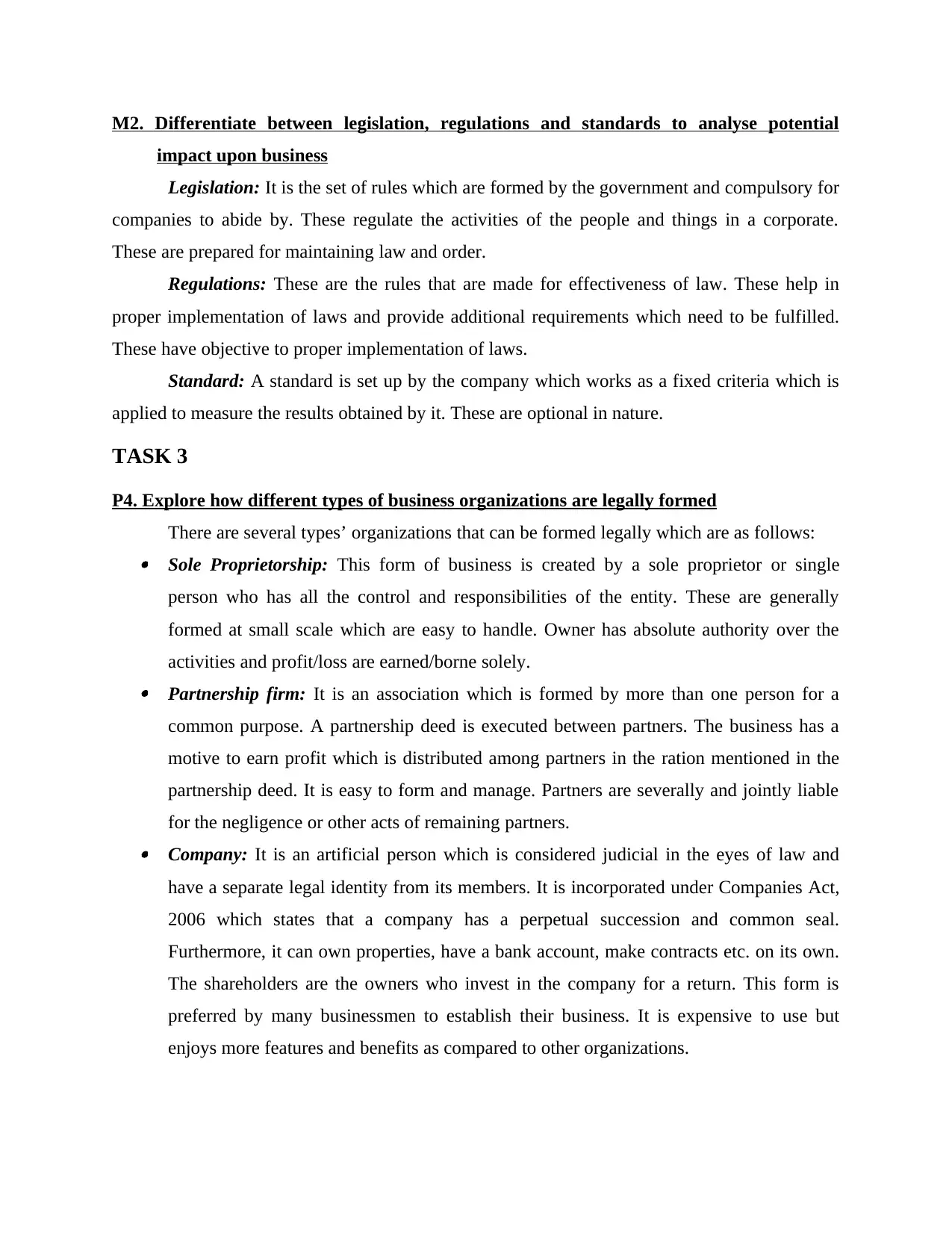
M2. Differentiate between legislation, regulations and standards to analyse potential
impact upon business
Legislation: It is the set of rules which are formed by the government and compulsory for
companies to abide by. These regulate the activities of the people and things in a corporate.
These are prepared for maintaining law and order.
Regulations: These are the rules that are made for effectiveness of law. These help in
proper implementation of laws and provide additional requirements which need to be fulfilled.
These have objective to proper implementation of laws.
Standard: A standard is set up by the company which works as a fixed criteria which is
applied to measure the results obtained by it. These are optional in nature.
TASK 3
P4. Explore how different types of business organizations are legally formed
There are several types’ organizations that can be formed legally which are as follows: Sole Proprietorship: This form of business is created by a sole proprietor or single
person who has all the control and responsibilities of the entity. These are generally
formed at small scale which are easy to handle. Owner has absolute authority over the
activities and profit/loss are earned/borne solely. Partnership firm: It is an association which is formed by more than one person for a
common purpose. A partnership deed is executed between partners. The business has a
motive to earn profit which is distributed among partners in the ration mentioned in the
partnership deed. It is easy to form and manage. Partners are severally and jointly liable
for the negligence or other acts of remaining partners. Company: It is an artificial person which is considered judicial in the eyes of law and
have a separate legal identity from its members. It is incorporated under Companies Act,
2006 which states that a company has a perpetual succession and common seal.
Furthermore, it can own properties, have a bank account, make contracts etc. on its own.
The shareholders are the owners who invest in the company for a return. This form is
preferred by many businessmen to establish their business. It is expensive to use but
enjoys more features and benefits as compared to other organizations.
impact upon business
Legislation: It is the set of rules which are formed by the government and compulsory for
companies to abide by. These regulate the activities of the people and things in a corporate.
These are prepared for maintaining law and order.
Regulations: These are the rules that are made for effectiveness of law. These help in
proper implementation of laws and provide additional requirements which need to be fulfilled.
These have objective to proper implementation of laws.
Standard: A standard is set up by the company which works as a fixed criteria which is
applied to measure the results obtained by it. These are optional in nature.
TASK 3
P4. Explore how different types of business organizations are legally formed
There are several types’ organizations that can be formed legally which are as follows: Sole Proprietorship: This form of business is created by a sole proprietor or single
person who has all the control and responsibilities of the entity. These are generally
formed at small scale which are easy to handle. Owner has absolute authority over the
activities and profit/loss are earned/borne solely. Partnership firm: It is an association which is formed by more than one person for a
common purpose. A partnership deed is executed between partners. The business has a
motive to earn profit which is distributed among partners in the ration mentioned in the
partnership deed. It is easy to form and manage. Partners are severally and jointly liable
for the negligence or other acts of remaining partners. Company: It is an artificial person which is considered judicial in the eyes of law and
have a separate legal identity from its members. It is incorporated under Companies Act,
2006 which states that a company has a perpetual succession and common seal.
Furthermore, it can own properties, have a bank account, make contracts etc. on its own.
The shareholders are the owners who invest in the company for a return. This form is
preferred by many businessmen to establish their business. It is expensive to use but
enjoys more features and benefits as compared to other organizations.
⊘ This is a preview!⊘
Do you want full access?
Subscribe today to unlock all pages.

Trusted by 1+ million students worldwide
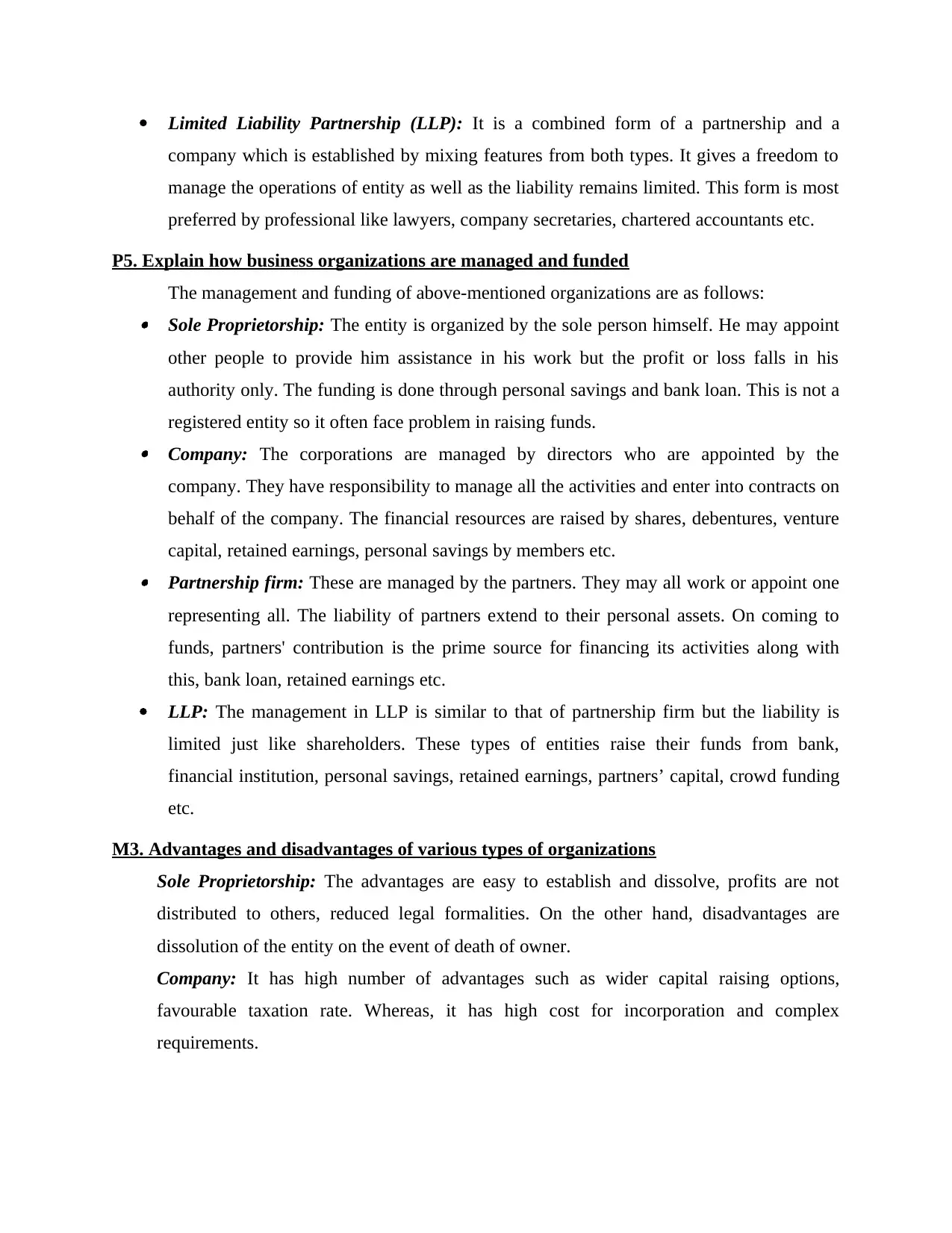
Limited Liability Partnership (LLP): It is a combined form of a partnership and a
company which is established by mixing features from both types. It gives a freedom to
manage the operations of entity as well as the liability remains limited. This form is most
preferred by professional like lawyers, company secretaries, chartered accountants etc.
P5. Explain how business organizations are managed and funded
The management and funding of above-mentioned organizations are as follows: Sole Proprietorship: The entity is organized by the sole person himself. He may appoint
other people to provide him assistance in his work but the profit or loss falls in his
authority only. The funding is done through personal savings and bank loan. This is not a
registered entity so it often face problem in raising funds. Company: The corporations are managed by directors who are appointed by the
company. They have responsibility to manage all the activities and enter into contracts on
behalf of the company. The financial resources are raised by shares, debentures, venture
capital, retained earnings, personal savings by members etc. Partnership firm: These are managed by the partners. They may all work or appoint one
representing all. The liability of partners extend to their personal assets. On coming to
funds, partners' contribution is the prime source for financing its activities along with
this, bank loan, retained earnings etc.
LLP: The management in LLP is similar to that of partnership firm but the liability is
limited just like shareholders. These types of entities raise their funds from bank,
financial institution, personal savings, retained earnings, partners’ capital, crowd funding
etc.
M3. Advantages and disadvantages of various types of organizations
Sole Proprietorship: The advantages are easy to establish and dissolve, profits are not
distributed to others, reduced legal formalities. On the other hand, disadvantages are
dissolution of the entity on the event of death of owner.
Company: It has high number of advantages such as wider capital raising options,
favourable taxation rate. Whereas, it has high cost for incorporation and complex
requirements.
company which is established by mixing features from both types. It gives a freedom to
manage the operations of entity as well as the liability remains limited. This form is most
preferred by professional like lawyers, company secretaries, chartered accountants etc.
P5. Explain how business organizations are managed and funded
The management and funding of above-mentioned organizations are as follows: Sole Proprietorship: The entity is organized by the sole person himself. He may appoint
other people to provide him assistance in his work but the profit or loss falls in his
authority only. The funding is done through personal savings and bank loan. This is not a
registered entity so it often face problem in raising funds. Company: The corporations are managed by directors who are appointed by the
company. They have responsibility to manage all the activities and enter into contracts on
behalf of the company. The financial resources are raised by shares, debentures, venture
capital, retained earnings, personal savings by members etc. Partnership firm: These are managed by the partners. They may all work or appoint one
representing all. The liability of partners extend to their personal assets. On coming to
funds, partners' contribution is the prime source for financing its activities along with
this, bank loan, retained earnings etc.
LLP: The management in LLP is similar to that of partnership firm but the liability is
limited just like shareholders. These types of entities raise their funds from bank,
financial institution, personal savings, retained earnings, partners’ capital, crowd funding
etc.
M3. Advantages and disadvantages of various types of organizations
Sole Proprietorship: The advantages are easy to establish and dissolve, profits are not
distributed to others, reduced legal formalities. On the other hand, disadvantages are
dissolution of the entity on the event of death of owner.
Company: It has high number of advantages such as wider capital raising options,
favourable taxation rate. Whereas, it has high cost for incorporation and complex
requirements.
Paraphrase This Document
Need a fresh take? Get an instant paraphrase of this document with our AI Paraphraser
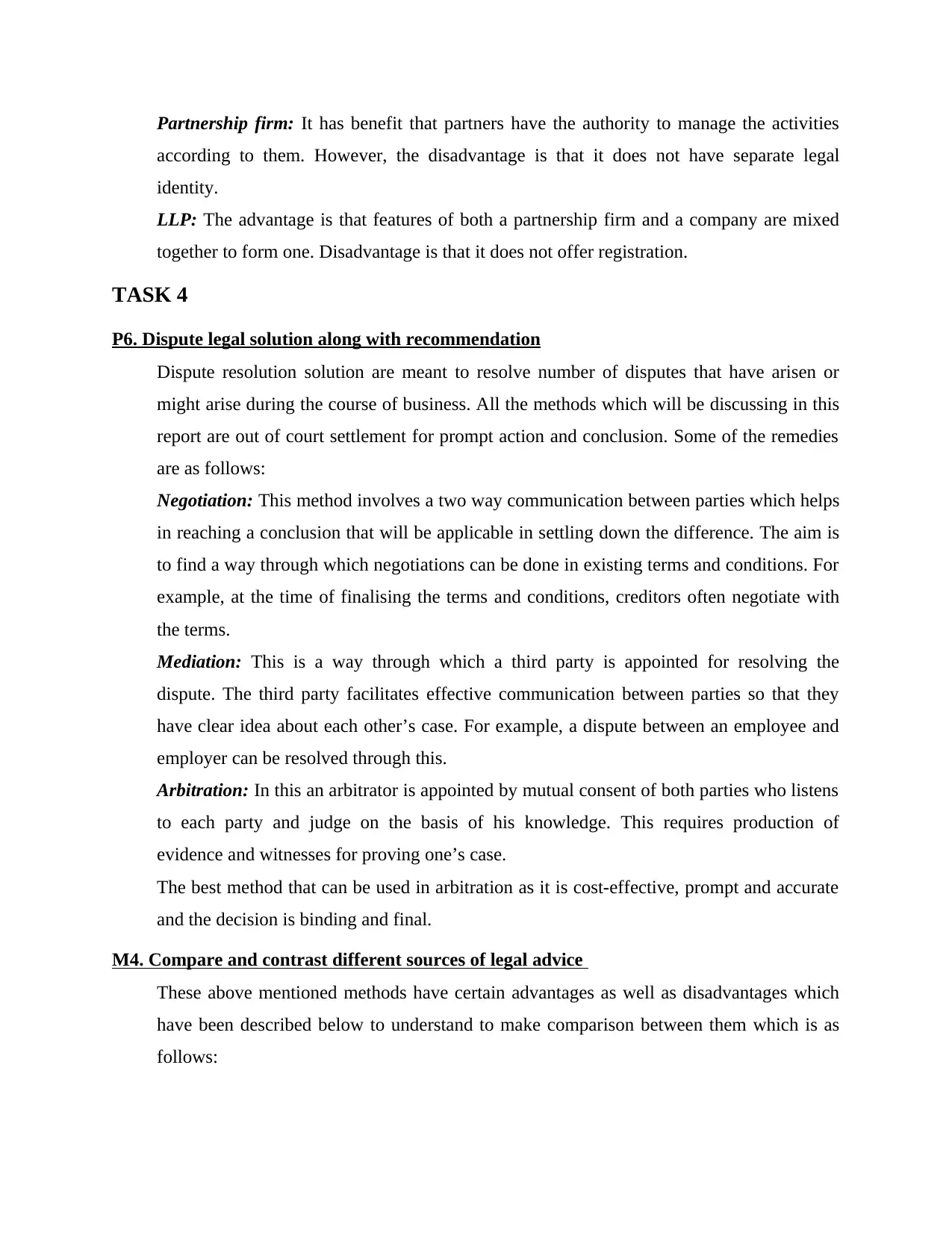
Partnership firm: It has benefit that partners have the authority to manage the activities
according to them. However, the disadvantage is that it does not have separate legal
identity.
LLP: The advantage is that features of both a partnership firm and a company are mixed
together to form one. Disadvantage is that it does not offer registration.
TASK 4
P6. Dispute legal solution along with recommendation
Dispute resolution solution are meant to resolve number of disputes that have arisen or
might arise during the course of business. All the methods which will be discussing in this
report are out of court settlement for prompt action and conclusion. Some of the remedies
are as follows:
Negotiation: This method involves a two way communication between parties which helps
in reaching a conclusion that will be applicable in settling down the difference. The aim is
to find a way through which negotiations can be done in existing terms and conditions. For
example, at the time of finalising the terms and conditions, creditors often negotiate with
the terms.
Mediation: This is a way through which a third party is appointed for resolving the
dispute. The third party facilitates effective communication between parties so that they
have clear idea about each other’s case. For example, a dispute between an employee and
employer can be resolved through this.
Arbitration: In this an arbitrator is appointed by mutual consent of both parties who listens
to each party and judge on the basis of his knowledge. This requires production of
evidence and witnesses for proving one’s case.
The best method that can be used in arbitration as it is cost-effective, prompt and accurate
and the decision is binding and final.
M4. Compare and contrast different sources of legal advice
These above mentioned methods have certain advantages as well as disadvantages which
have been described below to understand to make comparison between them which is as
follows:
according to them. However, the disadvantage is that it does not have separate legal
identity.
LLP: The advantage is that features of both a partnership firm and a company are mixed
together to form one. Disadvantage is that it does not offer registration.
TASK 4
P6. Dispute legal solution along with recommendation
Dispute resolution solution are meant to resolve number of disputes that have arisen or
might arise during the course of business. All the methods which will be discussing in this
report are out of court settlement for prompt action and conclusion. Some of the remedies
are as follows:
Negotiation: This method involves a two way communication between parties which helps
in reaching a conclusion that will be applicable in settling down the difference. The aim is
to find a way through which negotiations can be done in existing terms and conditions. For
example, at the time of finalising the terms and conditions, creditors often negotiate with
the terms.
Mediation: This is a way through which a third party is appointed for resolving the
dispute. The third party facilitates effective communication between parties so that they
have clear idea about each other’s case. For example, a dispute between an employee and
employer can be resolved through this.
Arbitration: In this an arbitrator is appointed by mutual consent of both parties who listens
to each party and judge on the basis of his knowledge. This requires production of
evidence and witnesses for proving one’s case.
The best method that can be used in arbitration as it is cost-effective, prompt and accurate
and the decision is binding and final.
M4. Compare and contrast different sources of legal advice
These above mentioned methods have certain advantages as well as disadvantages which
have been described below to understand to make comparison between them which is as
follows:
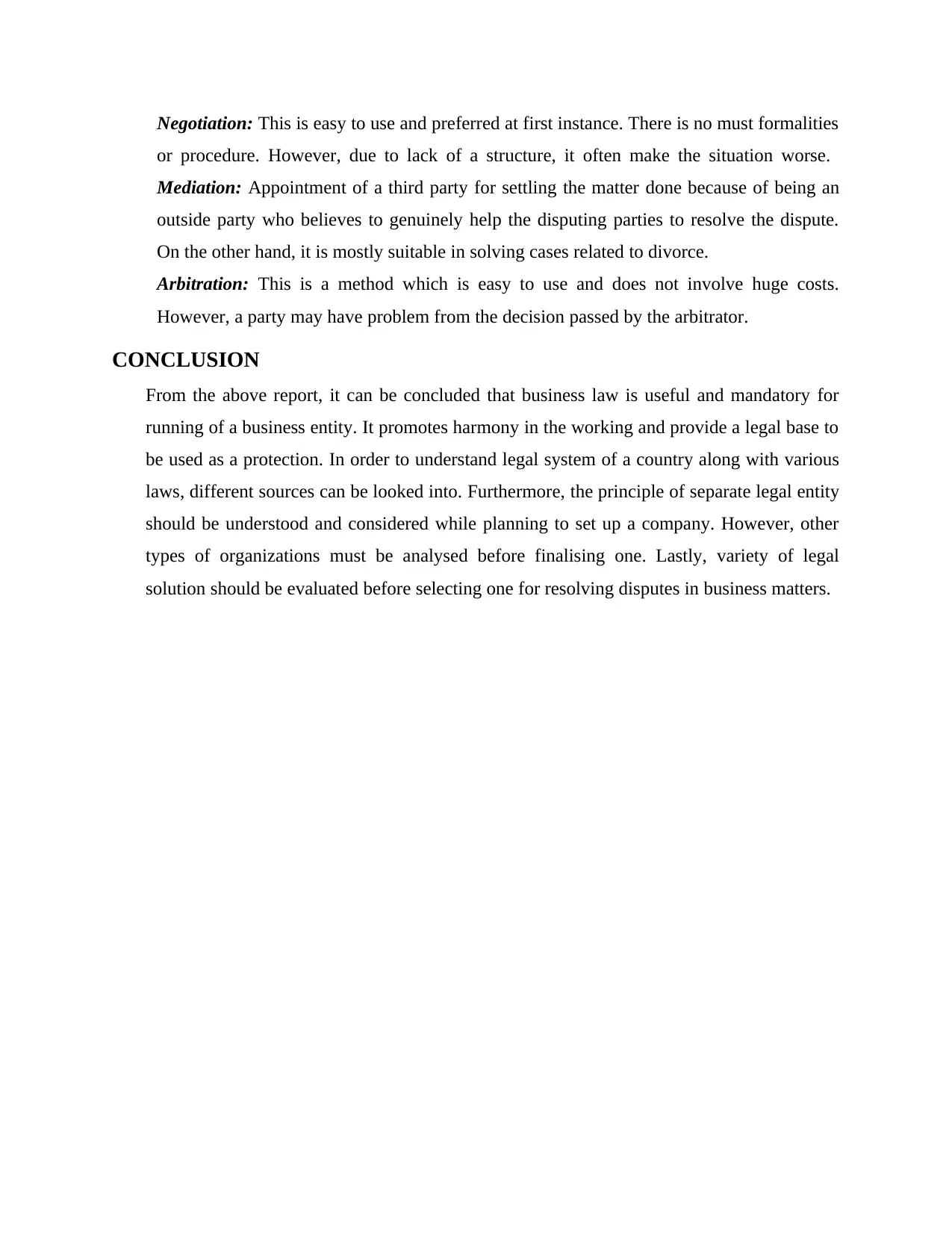
Negotiation: This is easy to use and preferred at first instance. There is no must formalities
or procedure. However, due to lack of a structure, it often make the situation worse.
Mediation: Appointment of a third party for settling the matter done because of being an
outside party who believes to genuinely help the disputing parties to resolve the dispute.
On the other hand, it is mostly suitable in solving cases related to divorce.
Arbitration: This is a method which is easy to use and does not involve huge costs.
However, a party may have problem from the decision passed by the arbitrator.
CONCLUSION
From the above report, it can be concluded that business law is useful and mandatory for
running of a business entity. It promotes harmony in the working and provide a legal base to
be used as a protection. In order to understand legal system of a country along with various
laws, different sources can be looked into. Furthermore, the principle of separate legal entity
should be understood and considered while planning to set up a company. However, other
types of organizations must be analysed before finalising one. Lastly, variety of legal
solution should be evaluated before selecting one for resolving disputes in business matters.
or procedure. However, due to lack of a structure, it often make the situation worse.
Mediation: Appointment of a third party for settling the matter done because of being an
outside party who believes to genuinely help the disputing parties to resolve the dispute.
On the other hand, it is mostly suitable in solving cases related to divorce.
Arbitration: This is a method which is easy to use and does not involve huge costs.
However, a party may have problem from the decision passed by the arbitrator.
CONCLUSION
From the above report, it can be concluded that business law is useful and mandatory for
running of a business entity. It promotes harmony in the working and provide a legal base to
be used as a protection. In order to understand legal system of a country along with various
laws, different sources can be looked into. Furthermore, the principle of separate legal entity
should be understood and considered while planning to set up a company. However, other
types of organizations must be analysed before finalising one. Lastly, variety of legal
solution should be evaluated before selecting one for resolving disputes in business matters.
⊘ This is a preview!⊘
Do you want full access?
Subscribe today to unlock all pages.

Trusted by 1+ million students worldwide
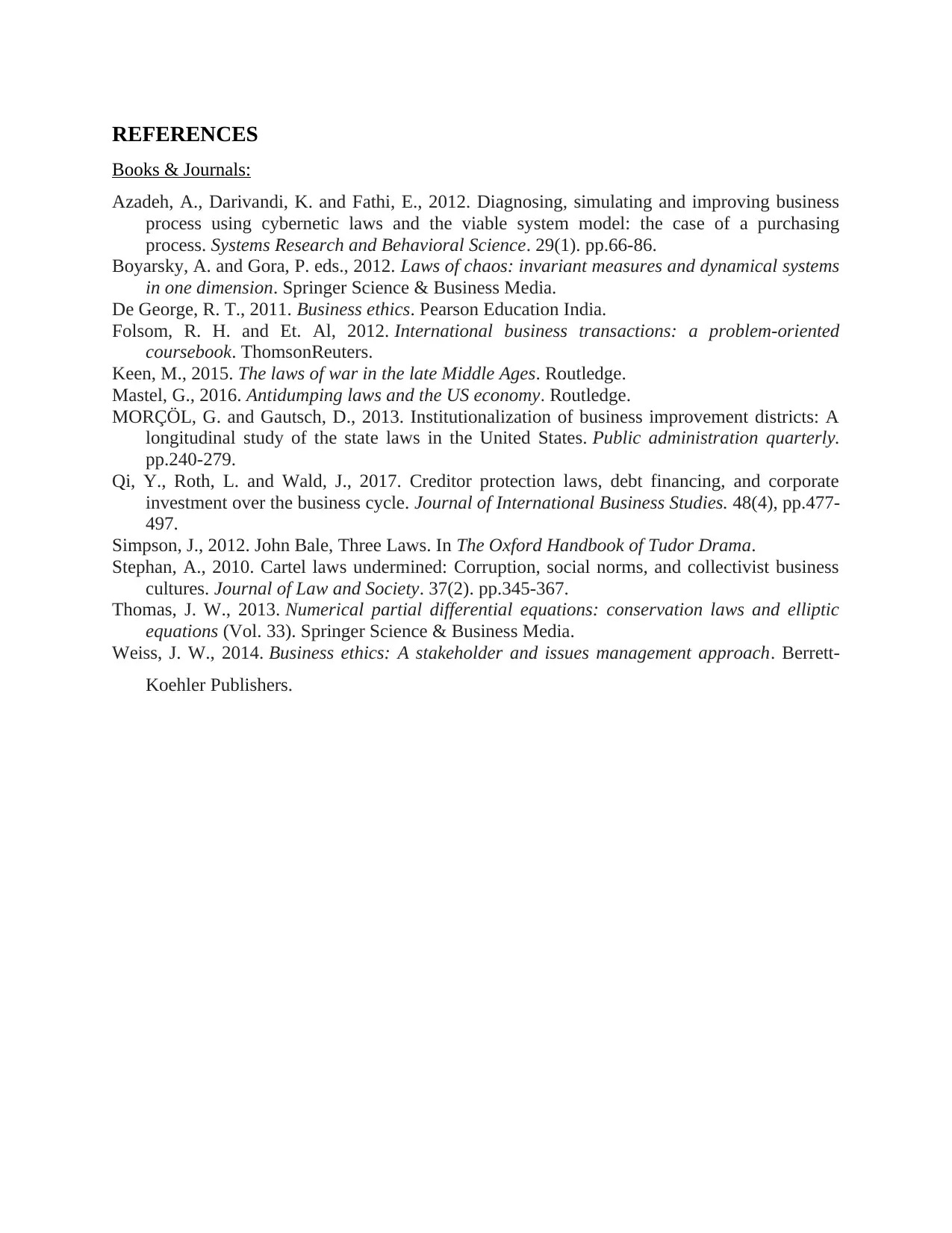
REFERENCES
Books & Journals:
Azadeh, A., Darivandi, K. and Fathi, E., 2012. Diagnosing, simulating and improving business
process using cybernetic laws and the viable system model: the case of a purchasing
process. Systems Research and Behavioral Science. 29(1). pp.66-86.
Boyarsky, A. and Gora, P. eds., 2012. Laws of chaos: invariant measures and dynamical systems
in one dimension. Springer Science & Business Media.
De George, R. T., 2011. Business ethics. Pearson Education India.
Folsom, R. H. and Et. Al, 2012. International business transactions: a problem-oriented
coursebook. ThomsonReuters.
Keen, M., 2015. The laws of war in the late Middle Ages. Routledge.
Mastel, G., 2016. Antidumping laws and the US economy. Routledge.
MORÇÖL, G. and Gautsch, D., 2013. Institutionalization of business improvement districts: A
longitudinal study of the state laws in the United States. Public administration quarterly.
pp.240-279.
Qi, Y., Roth, L. and Wald, J., 2017. Creditor protection laws, debt financing, and corporate
investment over the business cycle. Journal of International Business Studies. 48(4), pp.477-
497.
Simpson, J., 2012. John Bale, Three Laws. In The Oxford Handbook of Tudor Drama.
Stephan, A., 2010. Cartel laws undermined: Corruption, social norms, and collectivist business
cultures. Journal of Law and Society. 37(2). pp.345-367.
Thomas, J. W., 2013. Numerical partial differential equations: conservation laws and elliptic
equations (Vol. 33). Springer Science & Business Media.
Weiss, J. W., 2014. Business ethics: A stakeholder and issues management approach. Berrett-
Koehler Publishers.
Books & Journals:
Azadeh, A., Darivandi, K. and Fathi, E., 2012. Diagnosing, simulating and improving business
process using cybernetic laws and the viable system model: the case of a purchasing
process. Systems Research and Behavioral Science. 29(1). pp.66-86.
Boyarsky, A. and Gora, P. eds., 2012. Laws of chaos: invariant measures and dynamical systems
in one dimension. Springer Science & Business Media.
De George, R. T., 2011. Business ethics. Pearson Education India.
Folsom, R. H. and Et. Al, 2012. International business transactions: a problem-oriented
coursebook. ThomsonReuters.
Keen, M., 2015. The laws of war in the late Middle Ages. Routledge.
Mastel, G., 2016. Antidumping laws and the US economy. Routledge.
MORÇÖL, G. and Gautsch, D., 2013. Institutionalization of business improvement districts: A
longitudinal study of the state laws in the United States. Public administration quarterly.
pp.240-279.
Qi, Y., Roth, L. and Wald, J., 2017. Creditor protection laws, debt financing, and corporate
investment over the business cycle. Journal of International Business Studies. 48(4), pp.477-
497.
Simpson, J., 2012. John Bale, Three Laws. In The Oxford Handbook of Tudor Drama.
Stephan, A., 2010. Cartel laws undermined: Corruption, social norms, and collectivist business
cultures. Journal of Law and Society. 37(2). pp.345-367.
Thomas, J. W., 2013. Numerical partial differential equations: conservation laws and elliptic
equations (Vol. 33). Springer Science & Business Media.
Weiss, J. W., 2014. Business ethics: A stakeholder and issues management approach. Berrett-
Koehler Publishers.
Paraphrase This Document
Need a fresh take? Get an instant paraphrase of this document with our AI Paraphraser


⊘ This is a preview!⊘
Do you want full access?
Subscribe today to unlock all pages.

Trusted by 1+ million students worldwide
1 out of 14
Related Documents
Your All-in-One AI-Powered Toolkit for Academic Success.
+13062052269
info@desklib.com
Available 24*7 on WhatsApp / Email
![[object Object]](/_next/static/media/star-bottom.7253800d.svg)
Unlock your academic potential
Copyright © 2020–2025 A2Z Services. All Rights Reserved. Developed and managed by ZUCOL.




